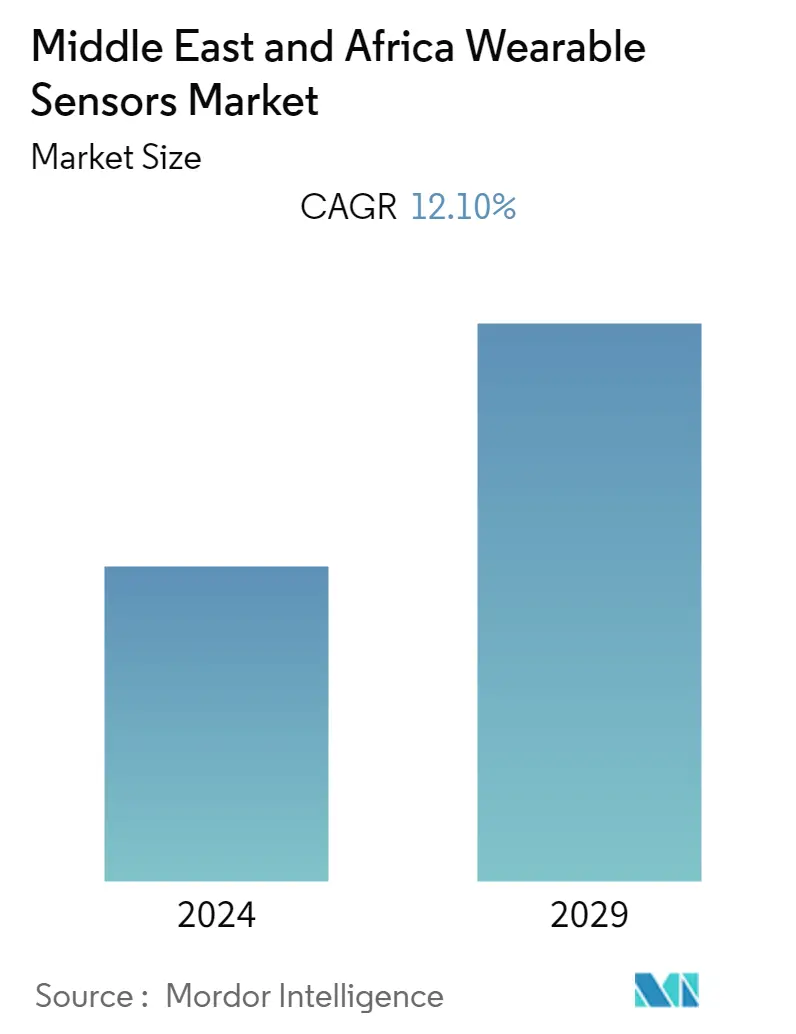Market Size of Middle East and Africa Wearable Sensors Industry

| Study Period | 2019 - 2029 |
| Base Year For Estimation | 2023 |
| Forecast Data Period | 2024 - 2029 |
| Historical Data Period | 2019 - 2022 |
| CAGR | 12.10 % |
| Market Concentration | Medium |
Major Players
*Disclaimer: Major Players sorted in no particular order |
Need a report that reflects how COVID-19 has impacted this market and its growth?
Middle East and Africa Wearable Sensors Market Analysis
The Middle East and Africa Wearable Sensor market is expected to register a CAGR of 12.1% over the forecast period. Wearable sensors are gaining popularity in digital systems like health monitoring systems due to ongoing developments in modern technologies and miniature circuits. Wearable technology generally includes sensors and wireless connections, allowing users to monitor, track, and analyze data. Various accessories, including wristbands, eyeglasses, headphones, and smartphones, are combined with these wearable sensor systems.
- Increased spending on consumer electronics, improved lifestyles, and a surge in urbanization has led to the region's rise in health and safety awareness. With rising disposable incomes, devices like smart wristbands, smartwatches, fitness trackers, VR headsets, activity trackers, sports watches, healthcare applications, enterprise, and industrial applications, are gaining huge traction.
- According to Saudi Arabian Monetary Agency, consumer spending in Saudi Arabia increased to SAR 343,374 Million in the first quarter of 2022 from SAR 333,555 Million in the fourth quarter of 2021. Furthermore, According to OECD, Israel's economy will grow by 4.9% in 2022 and 4% in 2023.
- One significant factor anticipated to drive the wearable sensors market during the forecast period is the growing elderly population. Over the coming decades, Saudi Arabia's aging population will rapidly grow. The senior population in Saudi Arabia will rise from 5.6% in 2017 to 22.9% by 2050, according to UN projections. Furthermore, according to the United nations population fund, Egypt is undergoing a demographic transition as the number of people over 60 is predicted to more than double from 8.4 million (8% of the overall population) to 22 million between 2020 and 2050 (14%).
- COVID-19 has changed the world and pushed countries to adopt new technology and search for practical and cost-effective solutions to manage the pandemic and reduce its negative impacts on the economy and people's lives. The healthcare sector in the region has faced critical issues like patient overload, compromised safety of healthcare workers, and healthcare resource shortages. Smart wearable devices that use IoT technology can enable patients to track their own health and help healthcare providers deliver immediate care when needed. These devices can also monitor and record symptoms and then analyze them to predict disease. Many countries in the region, like Saudi Arabia - with its vision 2030, have implemented the IoT in their health sectors and leveraged its benefits to fight COVID-19.
- Further, the market is currently flooded with smart, Internet-connected products, and the number is expanding quickly. The primary condition for enabling effective sensor data and information exchange is standardization. A few businesses have developed standards for sensor communication. For example, the OGC's Sensor Web Enablement (SWE) measures satisfy the need for improved sensor connectivity in extremely complicated and basic applications. Thousands of geospatial applications that use the OGC or other standards may easily incorporate this data thanks to the SWE standards. Interoperability problems are also brought on by the absence of universal standards for sensor communication.
